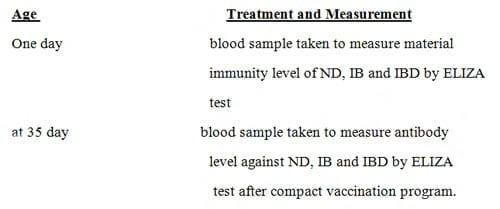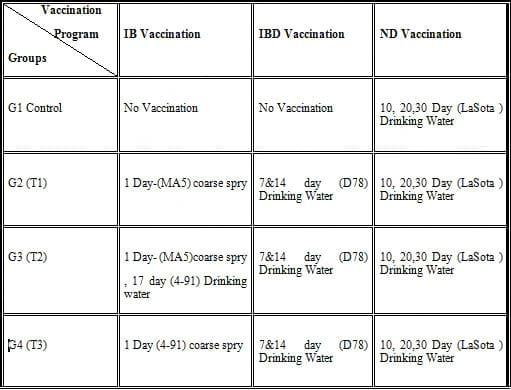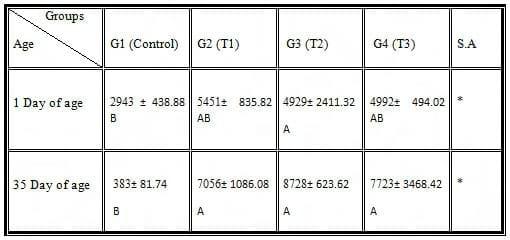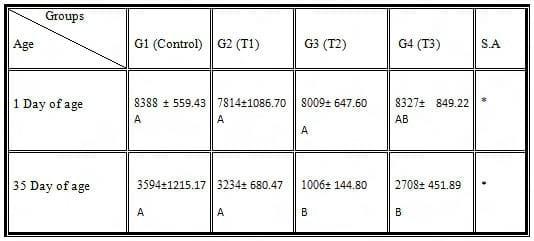Vaccination Against Infectious Bronchitis and Infectious Bursal Disease in poultry
Find the Best Way to Vaccination Against Infectious Bronchitis and Infectious Bursal Disease
A study to find best way of vaccination to protect from Infectious Bronchitis (IB) and Infectious Bursal Disease (IBD) was done in Girdereshe farm which belong to Agriculture College-Salaheddin University.
In the experiment 240 chicks of Cobb broiler breeder reared and the birds divided in to 4 groups (60 bird/group) as follow: control group which vaccinated just against Newcastle Disease (ND) with Lasota strain via drinking water (DW) at 10, 20 and 30 days of age. The group 2 (T1) was vaccinated against ND as control group in addition to vaccination against IB with MA5 strain at one day of age via coarse spray and vaccination against IBD via DW method with D78 strain at 7 and 14 days of age, while group 3 (T2) was vaccinated against ND as pervious groups as well as vaccination against IB with MA5 strain at one day of age by coarse spray, then by DW with 4-91 strain at 17 days of age, in addition of vaccination against IBD via DW at 7 and 14 days of age with D78 strain.
The last group 4 (T3) vaccinated by some way of pervious groups against ND, in addition to vaccination against IB via coarse spray with 4-91 strain at 1 days of age pulse vaccination against IBD via DW at 7 and 14 days of age with D78 strain.
The mortality rate of experimented was with normal range about 10 % and mean of body weight was 2.4 kg at 42 days.
The results of study indicate the group T1 show best antibodies titer against the diseases when compared with titers of antibody of other groups which mean that the ways used with the groups and the strain which choose to be given in the vaccine of the virus induce high titer of antibodies against the both diseases IB and IBD when blood sample tested at 35 days of age by ELIZA technique after ending vaccination program.





Haider Mansour
Doctor in vet hospital in Najaf /Iraq
These programs especially IB vaccine is not useful in my country because these strains don't match with the local strain.
To get a good vaccine for IB you must isolate the local strain and make from it vaccine this your method applied in my area and failure it.
I am the student of M.Sc poultry science, my research topic is related to infectious bronchitis and vaccine preparation against IBV. I want you let me know how can I propagate the IB virus in laboratory for vaccine production? and what is the best method of killing this virus to prepare killed vaccines?
From my field experience in Egypt and other Arab countries , always using a dead vaccine at day old of IB-ND-IBD
0.2 ml S/c at day old specially in endemic areas simultaneously with the recommended doses of life vaccines for the same mentioned diseases. This method of vaccination will be reflected on mortality rates, body gain & FCR
Article presentation is good and timely. In table no 2, we got post vaccination titre for Treatment 1 as 1542, are we sure it is a protective titre. Though protective level differs from one elisa kit to other, i think it should b min of 5000.
So it's better not to vaccination unless isolation of local strain of IB and prepare vaccines from them, because of unsuitabile vaccine lead to emerging new varient strains (rolling factor) and it's immunosuppressive effect on local immunity of Newcastle disease which is most important disease than IB in Iraq and kurdistan region.
Regardless of all vaccination programs, whether this program is good or that program, first of all I hope we isolate the local strains and prepare vaccines from them then applying the best program, because antigenic variation can induce failures on the vaccination processes due to the difference of antigenic structures between vaccinal and field viruses, many out breaks of IB appeared in most provinces in Iraq, it was thought that they were due to vaccination with unsuitable strain of IB, all the IB vaccines, which used are commercially imported and are not matched with serotypes that exist in layers and broilers in Iraq and kurdistan region. Consequently, this may emerge new variant strains of IB viruses, also there are many publications revealed that IB vaccines have immunosuppressive effect on local immunity of Newcastle disease vaccines.
Nice article but I have a comment on Ab titer in Table(3) regarding vaccination at age 7 days without to determine the optimal time of immunization may give you the result will be affected with maternal Ab and will give this difference, I hope for you all the best.
The author misinterpreted the results in Table no.2 for 1 day of age class. Vaccine effects could not be demonstrated since unvaccinated controls had the same non-significant antibody titer as compared to vaccination ones. Else, you could make a mistake in running your ELISA since control titers of unvaccinated controls were always found and at high levels.
Multiple range tests among treatments were wrongly indicated for 1 day of age class in Table Nos 3 and 4. For instance, G3 was A (4929) , G1 was B (2943) then it impossible that G2 with titer of 5451 was AB ( Table 3).
Better rewrite the article and consult someone on statistical analysis and data interpretation.














.jpg&w=3840&q=75)